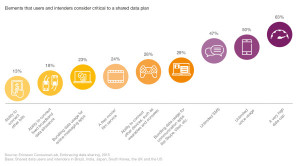 Ericsson ConsumerLabs has discovered that future shared data plan users will be very different from those of today, placing new demands on operators.
Ericsson ConsumerLabs has discovered that future shared data plan users will be very different from those of today, placing new demands on operators.
The company’s ‘Embracing Data Sharing’ report, has investigated how shared data plans and their introduction has impacted consumer behaviour, as well as triggers and barriers to their adoption.
“We found that about one quarter of smartphone users currently on shared data plans are ‘power users’, who consume large amounts of mobile data,” Jasmeet Singh Sethi, Senior Advisor, Ericsson ConsumerLab, said. “In the future, this proportion is expected to rise by 42 percent, which would equal 40 percent of all shared plan users across the six markets that we studied: Brazil, India, Japan, South Korea, the UK and the US.”
Ericsson ConsumerLab found that consumers’ main concerns are:
- Clear understanding of the cost involved
- A simple and streamlined offering that remains unchanged, even in the event of promotions
- Real-time transparency and plan management
- Enhancing the value of such plans by extending to new connected devices, like wearables
- Better app coverage (for heavy users).
Consumers are finding it hard to decipher the shared plans and need real-time transparency – 46 percent are discontented when it comes to understanding price plan options and billing, while two out of five are dissatisfied with the ability to track, modify and monitor their usage.
In the markets surveyed, a typical smartphone user household had at least six digital devices: three internet users; two mobile internet subscriptions; and an additional connectivity option such as fixed broadband.
“The growing number of options available is creating a high level of complexity in managing multiple subscriptions,” Singh Sethi said. “Consumers think shared data offerings can help solve this digital connectivity conundrum.”
When it comes to the adoption of shared data plans, there is great variation between the markets studied. In the US, for example, 26 percent of smartphone users surveyed are on such plans, while the corresponding figure for India and Brazil is only 5 percent.





